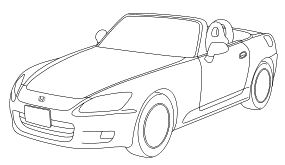















Honda S2000 |
|---|
|
| Topic Navigation |
|---|
|
Wikipedia: Honda S2000
Page Sections History Images Merchandise Article Index |
History
The following section is an excerpt from Wikipedia's Honda S2000 page on 31 May 2017, text available via the Creative Commons Attribution-ShareAlike 3.0 Unported License.
The Honda S2000 is a roadster that was manufactured by Japanese automaker Honda from 1999 to 2009. First shown as a concept car at the Tokyo Motor Show in 1995, the production version was launched in April 1999 to celebrate the company's 50th anniversary. The S2000 is named for its engine displacement of two liters, carrying on in the tradition of the S500, S600, and S800 roadsters of the 1960s.
Several revisions were made throughout the car's lifetime, including changes to the engine, gearbox, suspension, interior and exterior. Officially two variants exist: the initial launch model was given the chassis code AP1, though cosmetically similar, the facelifted version (known as the AP2 in the US) incorporated significant changes to the drivetrain and suspension. Production of the S2000 ceased in June 2009. In Japan, it was exclusively sold through the Honda Verno sales channel.
Introduced at the 1995 Tokyo Motor Show, the Honda Sport Study Model concept car was the design study for the production S2000. The SSM was a rear-wheel-drive roadster powered by a 2.0 L (122 cu in) inline four-cylinder engine. It featured a rigid 'high X-bone frame' which Honda claimed improved the vehicle's rigidity and collision safety. The concept car was constructed with aluminum body panels and featured a 50:50 weight distribution.
The SSM appeared in many automotive shows for several years afterwards, hinting at the possibility of a production version, which Honda announced in 1999.
First generation (AP1 - 1999–2003)
The S2000 was introduced in 1999 for the 2000 model year and was given the chassis designation of "AP1". It features a front mid-engine, rear-wheel-drive layout with power delivered by a 1,997 cc (122 cu in) inline four-cylinder DOHC-VTEC engine. The engine (codenamed F20C) produces outputs of 177–184 kW (237–247 hp), and 208–218 N·m (153–161 lbf·ft) depending on the target market. The engine is mated to a six-speed manual transmission and Torsen limited slip differential. The S2000 achieved what Honda claimed as "the world's top level, high performance four-cylinder naturally aspirated engine".
Features include independent double wishbone suspension, electrically assisted steering and integrated roll hoops. The car features 16 in (41 cm) wheels with Bridgestone Potenza S-02 tires. The compact and lightweight engine, mounted entirely behind the front axle, allow the S2000 to achieve a 50:50 front/rear weight distribution and lower rotational inertia. An electrically powered vinyl top with internal cloth lining was standard, with an aluminum hardtop available as an optional extra (in 2001). Honda offered Berlina Black, New Formula Red, Gran Prix White, Sebring Silver and Silverstone Metallic in the US domestic market.
The 2001 model was largely unchanged; Honda added a digital clock to the radio display and made the rear wind blocker standard. Honda also added Spa Yellow to the US domestic market lineup. For the 2002 model year, suspension settings were revised and the plastic rear window was replaced by a glass unit incorporating an electric defroster. Other updates included slightly revised tail lamps with chrome rings, an upgraded radio with separate tweeters, a leather gearshift knob, leatherette console cover and a revised engine control unit. Honda added Suzuka Blue to the US domestic market lineup.
The AP1 was manufactured up to 2003 at Honda's Takanezawa plant, alongside the Honda NSX and Honda Insight hybrid.
Second generation (known as "AP2" and in Europe as "AP1 facelift" - 2004–2009)
The 2004 model S2000 underwent several significant changes. Production moved to Suzuka. The new model introduced 17 in (43 cm) wheels and Bridgestone RE-050 tires along with a retuned suspension to reduce oversteer. The spring rates and shock absorber damping were altered and the suspension geometry modified to improve stability by reducing toe-in changes under cornering loads. The subframe also received a revision in design to achieve a high rigidity. In the gearbox the brass synchronizers were replaced with carbon fiber. In addition, cosmetic changes were made to the exterior with new front and rear bumpers, revised headlight assemblies, new LED tail-lights, and oval-tipped exhausts. Although all the cosmetic, suspension and most drivetrain upgrades were included on the Japanese, Australian and European S2000s, they retained the 2.0l F20C engines and remained designated as AP1s.
For the North American market the updates also included the introduction of a larger version of the F20C (F22C1), this larger engine gave the chassis designation AP2. F22C1, the engine's stroke was lengthened, increasing its displacement to 2,157 cc (132 cu in). At the same time, the redline and fuel cutoff were reduced from 8,800 rpm and 9,000 rpm to 8,000 rpm and 8,200 rpm respectively, mandated by the longer travel of the pistons. Peak torque increased 6% to 220 N·m (160 lbf·ft) at 6,800 rpm while power output remained unchanged, 177 kW (237 hp) at a lower 7,800 rpm. In conjunction with its introduction of the F22C1, Honda also changed the transmission gear ratios by shortening the first five gears and lengthening the sixth.
In 2006, the F22C1 was also introduced to the Japanese market, with slightly higher outputs (178 kW (239 hp) and 221 N·m (163 lbf·ft)). The F20C continued in all other markets. The 2006 model introduced a drive by wire throttle, an electronic stability control system, new wheels, and one new exterior color, Laguna Blue Pearl. Interior changes included revised seats and additional stereo speakers integrated into the headrests.
 |
Public domain clip art image from WP Clipart
8KB |
| Type & Item # | Name | Details |
|---|---|---|
| Die Cast - Road & Track 21094 | Power Racer, 1:43 scale, red |
| Date | Article | Author/Source |
|---|---|---|
| 10 July 2009 | 2009 Honda S2000: Requiem For A Real Sports Car | Mac Demere |
